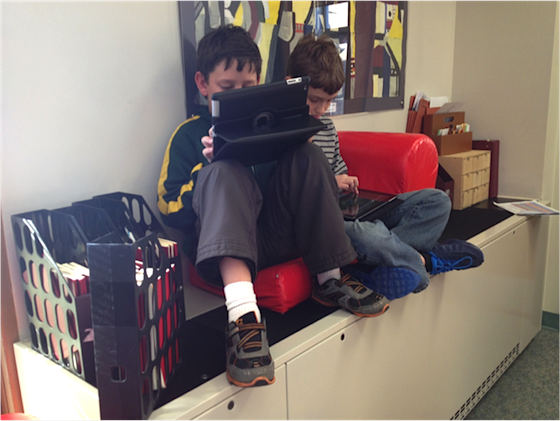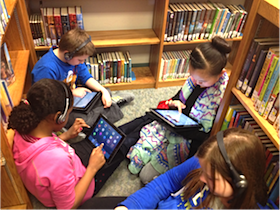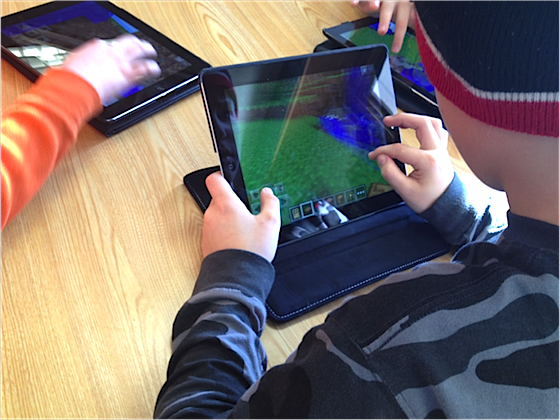Principal Matt Renwick is sharing weekly reflections about an afternoon computer club he and a teacher are sponsoring as an enrichment activity. (Here are the links to this eight-part series: Part 1, Part 2, Part 3, Part 4, Part 5, Part 6 and Part 7 and Part 8.)
My co-teacher Renee was sitting next to two students while they played within one of their Minecraft worlds on their iPads. Totally immersed, they hardly noticed that she was in their presence.
“I have watched students play this game many times, and I still don’t get it,” Renee admitted to me.
I peeked over another group’s shoulders and watched their screens, wondering the same thing myself. Our students have shown an amazing ability to sustain focus on the worlds they create, build, destroy, and create again. There is no need to develop “stamina” with Minecraft, like we might with a more school-related task such as silent reading. (Unrelated: Why do they select such weird locations to play these games?)

Understanding motivation
Always a teacher, I am continuously thinking about how we can guide our students toward producing authentic examples of what they are learning through this game. Our state department of education, which provided the funding for our club, would like some data to show the level of effectiveness of our activities in terms of student learning.
It is also important that we assess the potential these activities have for integration within our general instruction. We have been assigning badges for certain types of accomplishments within Edmodo, such as “Star Performer” if they uploaded a video of themselves giving a book talk. Our thinking is that these types of motivators will encourage our students to produce more tangible, project-like results.
But some students just aren’t motivated by badges. Even though we have taken time each week to recognize our most active students within Edmodo, some students are very content with playing Minecraft with their friends. Is this okay too? When we try to insert “school” into our computer club, are we also potentially sucking the passion out of this experience in the process?
Other students know how to play the game of School very well. Each time they accomplish a task, they are quickly asking one of us, “Where’s my badge?” This shouldn’t be what they are working for, but then again, we teachers created this system in the first place.
 Motivation has been a big focus in the education world, especially since the publication of the seminal resource Mindset by Dr. Carol Dweck (Ballantine, 2006). She has coined the phrase “growth mindset.”
Motivation has been a big focus in the education world, especially since the publication of the seminal resource Mindset by Dr. Carol Dweck (Ballantine, 2006). She has coined the phrase “growth mindset.”
Summarizing several research studies she has conducted, people with a growth mindset see failures and challenges as opportunities for learning. “People in a growth mindset don’t just seek challenge, they thrive on it. The bigger the challenge, the more they stretch” (p 21).
The other side of this coin is the term “fixed mindset.” Those with this outlook see struggles only in a negative light. They are afraid they will be perceived as unintelligent if they make mistakes, and that intelligence is a fixed trait. “If failure means you lack competence or potential – that you are a failure – where do you go from there?” (p 35).
The Mindset of Minecraft
Having this background knowledge about motivation, we reassessed the type of work we were doing. Here are some indicators that the skills the students are naturally learning while playing Minecraft might actually be helping them develop essential lifelong skills.
- Persistence
Besides a few minor behavior issues, not one student has come up to us and asked that we help them solve a problem within Minecraft. Not one. When a student struggles to build a shelter, or collect different items, they turn to each other for support. If they don’t find the help they need, they keep trying by considering a different strategy.
- Attitude
One of my favorite things about Minecraft: If you die, they don’t say “Game Over.” Instead, you get the redundant response “You Died.” Thanks, Captain Obvious! But in all seriousness, this type of specific feedback does not judge their performance or the reason for their demise. The player is allowed to “re-spawn” themselves and get back to work. This reinforces the idea that failure is simply an opportunity to learn.
- Effort
When they enter Minecraft, students aren’t offered options for different levels of challenge or “ability.” Everyone is on the same playing field. Also, Minecraft isn’t timed (unless you count the zombies coming out at night). You take the resources given and build what you want according to your own schedule. In addition, the feedback received by the player is not reduced to a score. It is evident in the outcome of one’s efforts, whether that be a two-story building or a simple garden.

The bottom line is the kids are having a lot of fun. They are passionate about their work, and this work might be paying off in developing executive skills that will benefit them now and down the road. In addition, they are creating complex worlds that require from them high levels of cognition and reflection.
What about curriculum?
But the question still remains: Is there any possibility in harnessing the motivational factor of Minecraft and instilling it within the general curriculum? For example, could the structures they are developing resemble ruins from ancient civilizations, or famous battlefields of U.S. history? If the answer is yes, how do we guide our students to realize the potential in these tools not only for creation and innovation, but also for integration within important curricular topics?
Our instincts tell us that these opportunities will present themselves when the time is right. For now, we are content with observing our students build not only complex worlds within Minecraft, but also develop key critical skills that can foster a growth mindset. The persistence, attitude, and effort observed in our students is all the evidence we need for now.
Matt Renwick
Latest posts by Matt Renwick (see all)
- How Do Digital Portfolios Help Students Learn? - August 1, 2014
- Should We Unconnect from Our PLNs Over Summer Break? - July 3, 2014
- Passion-Based Learning, Week 8: The End of the Beginning - April 30, 2014


Check out MinecraftEDU and @minecraftteacher on twitter
Thanks Mary for sharing.
Thanks Mary.
This teacher looks like she’s using it to touch on all of her cores subjects while integrating it in her classroom: http://theminecraftedclassroom.blogspot.com/2014/03/welcome-to-our-world.html
Margaret, thank you for sharing the post. I am inspired by this teacher’s courage to dive in and explore what’s possible. Whether it be Minecraft or another tool with potential, the best part with these types of experiments is the process as much as the product. Her students are so lucky to be a part of the endeavor.
do you have a pre-session and post-session meeting where they can share what they’re working on and what they did that day? that could help them teach one another and get interested in copying and extending each other’s ideas. what about printing screen grabs and displaying them so they can show what they’re working on? are you documenting their projects so parents and other kids and teachers can see what they’re doing? do they have the tools they need to create youtube tutorials?
Lori, we always have a pre-session where we teach a quick mini-lesson. As of late, our students have been teaching the lessons. We also sometimes stop the action midway to allow a student to share their creation and how they made it. Recent tools shared include Powtoon and WeVideo. Almost all of our projects have been posted in Edmodo, our learning management system. Parents are encouraged to join the Edmodo group and see what’s happening. As for tutorials, one of the first tools we explored is Screencast-0-matic. We also purchased headphones + mics, as well as several copies of Explain Everything for the iPads.
I hadn’t considered printing off their projects, but that is a good idea for certain products. Thank you for the questions and helping me reflect on our work.
Do a Google search and find an article called “Lessons From Skateboarders” by Richard Sagor. He captures this perfectly.
Will do Wendy – thanks!
I have created a scheme of work for my year 7/8 I included peer assessment marking sheets and lesson objectives I used this lesson in our last ofsted inspection with an outstanding outcome. I have instilled that when in class we use this as a learning platform only that the challenges given are for team work and collaborative learning .. There is no I when we use it in class . I have you tube videos of peer assessment and walk through a of their work and challenges. Minecraft has offered many teaching ideas . I have also taught coordinates with it using Disney world to create a treasure hunt using the coordinates .. We have also built flags from different countries using the block … Explore the creativity is endless and inspire the students to create a SOW also .
Thank you for sharing your ideas in this forum, Louiza.
Hi, Matt. I loved your series of posts about Passion-Based Learning with Minecraft. I hold http://www.rescola.com.br, a Brazilian website dedicated to disseminate and discuss ideas and initiatives dedicated to review, rethink, redo, and revolutionize education (“Reaprendendo a ensinar” or “Relearning to teach” is our motto). Experiences like yours are still very rare in Brazil and I’d love if the people here could know about what you are doing in your school. So, could I have your permission to translate your texts to portuguese and post them in our website? Of course, I’ll give your credit and make links to your original posts. Congratulations for your beautiful work. Regards.
Kind of you to say, Renato. Feel free to translate and repost on your site – honored! I’ll be sure to check out your site to explore more teaching and learning ideas.
Thank you, Matt. I’ll let you know when the texts are published. And please, be our guest to visit Rescola. 🙂 By now, we only have articles in portuguese, but we plan to start posting english versions soon.
We’re just finishing up a year of American History on Minecraft. Our admin is now preparing our events and servers to be used by any teachers anywhere: CelebrationEducation.com/minecraft
Cool idea, Heather! And what a way to provide that necessary purpose for students by sharing your creations with the world.
I’ve also been trying to gather resources on specific lessons, and I have bookmarked several teachers that are beginning to focus on specific skills connected to the Common Core. That being said, the last newsletter from Minecrafteud shared the repository they are creating and this looks like the best collection I’ve seen so far at: http://services.minecraftedu.com/worlds/
Derrall, thanks for sharing this resource. I like how the site you reference provides suggested age levels.
Great post, Matt. I agree that working in Minecraft fosters a wealth of skills and attitudes that we would like our students to have. Working collaboratively is great, especially when groups of students help each other – that’s one of my favourite things to stand back and watch! Thanks for sharing your experiences and thoughts.
That’s interesting Zoe, about collaboration and group work. Do you find that just giving kids time to play is most effective, or do you build in breaks during this experience to have face-to-face conversations, to reflect, and/or to consider goals?
Let me begin by saying that I applaud your student-centered approach to exploring technology in the school setting. I agree with much of what your article says. However, most of that could be said absent the specific context of Minecraft – a game about which I have some concerns.
In the 5 or so years since its inception, Minecraft has evolved to many different environments with many different options. Some of these environments and options fall outside the boundaries of what I’d consider school appropriate. Whatever the original intent or purpose of Minecraft might have been and no matter how much it looks like Legos, today several authorities on online gaming emphasize that Minecraft is not intended for children.
Worrisome is the feature that allows multiple players from anywhere in the world to play together — WITH the option of (unedited) text dialogue and character violence between players. We would certainly never allow total strangers into our physical school building; why would we let them into our students’ virtual environments? As well, in Minecraft there are several scary environments and many different creatures to kill. None of that seems school appropriate.
Mostly my concerns center on the 1st Person Perspective shooter aspects of the game. When my students have played the game during indoor recess, what I’ve heard most often is, “Killed him! Oh! I killed him!” over and over again. Indeed, in the way that marijuana is considered a gateway drug to more dangerous substance abuse, Minecraft looks like an introduction to 1st Person shooter video games — a genre of increasingly gory and violent games featuring recreational homicide. (In fact, 1st Person Perspective shooter games were pioneered by the military to prepare and desensitize soldiers to killing other human beings.)
So again, I can’t disagree with your premise nor even with the practice of following your students’ interests (I am a Montessori teacher after all). But our job as the adults in the room means that we also have to filter the choices our students make. I am inclined to filter out Minecraft in the school environment.
Charles, thank you for sharing your perspective.
@Charles
The education versions of Minecraft (Minecraftedu originally and now Microsoft’s Minecraft Education Edition) eliminate and/or give a teacher full control over the issues you are concerned with. They also add tools for managing classroom and creating lessons within Minecraft while retaining the positive aspects. In our school district we have measured an increase in engagement and student academic achievement when using MinecraftEdu as an instructional tool. We have been able to create worlds tailored to specific learning targets as well.